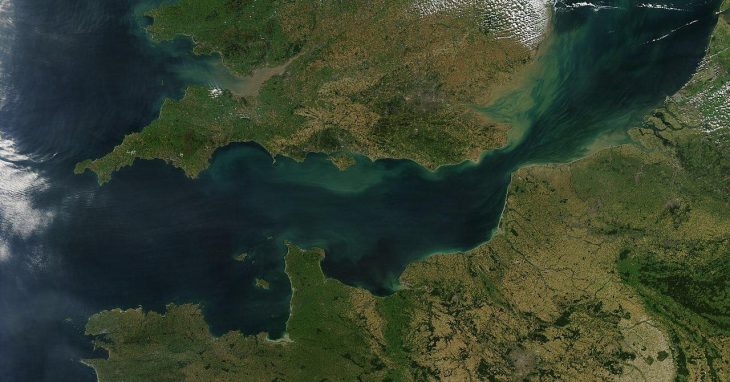
The English Channel, a body of water that separates southern England from northern France, has long captivated the imagination of adventurers, historians, and nature enthusiasts. In this article, we explore 18 intriguing facts about the English Channel, shedding light on its rich history, stunning natural beauty, and remarkable feats of human endurance. From its role in world wars to its diverse marine ecosystem and iconic landmarks, the English Channel holds a special place in the hearts of those who have witnessed its majesty firsthand.
Strategic Importance
Throughout history, the English Channel has served as a strategic waterway, influencing political and military affairs. Its proximity to Europe’s major powers and its narrowest point, known as the Strait of Dover, made it a crucial trade route and a desirable conquest for many empires.
The White Cliffs of Dover
One of the most iconic sights along the English Channel is the White Cliffs of Dover. These towering chalk cliffs have been an emblem of England for centuries and offer breathtaking views of the channel. They have also played a role in the nation’s defense, with their imposing presence serving as a natural barrier.
World War Connections
During both World Wars, the English Channel played a vital role. It served as a strategic route for military operations and witnessed significant naval engagements. The evacuation of Dunkirk during World War II, known as Operation Dynamo, involved the rescue of hundreds of thousands of Allied soldiers across the channel.
Channel Swimming
The English Channel is renowned for its challenging open-water swimming conditions, attracting daring individuals from around the world. Swimmers endeavor to cross the channel, facing strong currents, unpredictable weather, and frigid temperatures. Successful crossings are a testament to human endurance and determination.
Marine Diversity
Beneath the surface of the English Channel lies a diverse marine ecosystem. The channel is home to a wide array of species, including seals, dolphins, sharks, and various fish. Its nutrient-rich waters support a thriving ecosystem that contributes to the region’s biodiversity.
Channel Islands

The English Channel is also dotted with a collection of picturesque islands known as the Channel Islands. These islands, including Jersey, Guernsey, and Sark, offer stunning landscapes, unique wildlife, and a rich cultural heritage. They provide a tranquil escape and serve as a haven for nature lovers and history enthusiasts.
Underwater Crossings
In addition to swimmers, the English Channel has witnessed numerous daring underwater crossings. Scuba divers and free divers have explored its depths, uncovering submerged wrecks, and underwater caves, and encountering fascinating marine life.
Channel Tunnel
The Channel Tunnel, also known as the “Chunnel,” is an engineering marvel that connects England and France beneath the English Channel. This 50-kilometer-long tunnel accommodates trains and has revolutionized travel between the two countries, offering a fast and efficient transportation link.
Cross-Channel Ferries
Crossing the English Channel by ferry is a popular mode of transportation for both tourists and locals. The ferry routes connect various ports, allowing passengers to enjoy the scenic journey, breathtaking views, and the convenience of traveling between the two nations.
Historical Crossings
Throughout history, numerous individuals have made historic crossings of the English Channel. From the first successful swim by Matthew Webb in 1875 to the pioneering aviation feats of Louis Blériot and Amelia Earhart, these crossings have left an indelible mark on the annals of human achievement.
Channel Wildlife
The English Channel is a haven for diverse wildlife, attracting birdwatchers, marine enthusiasts, and nature photographers. The channel provides essential feeding grounds for seabirds, including gannets, puffins, and razorbills, while seals and dolphins can often be spotted swimming alongside boats.
Fishing Industry
The English Channel has supported a thriving fishing industry for centuries. Local fishermen venture out to sea, casting their nets and lines to catch a variety of fish, including cod, haddock, and sole. The channel’s abundant seafood plays a significant role in regional cuisine and gastronomy.
Geographical Significance
With a width that varies from 33 to 240 kilometers, the English Channel is an impressive geological feature. It has been shaped by natural forces over millions of years, and its depth reaches up to 180 meters at certain points, providing a fascinating study of the Earth’s geological history.
Coastal Attractions
The English Channel boasts a multitude of charming coastal towns and attractions. From the historic port city of Plymouth to the elegant resort town of Brighton, visitors can explore picturesque beaches, indulge in traditional fish and chips, and soak up the vibrant coastal atmosphere.
Environmental Conservation
Efforts to protect the English Channel’s unique ecosystem and preserve its natural beauty are ongoing. Organizations, such as marine conservation trusts, work tirelessly to promote sustainable practices, raise awareness about pollution, and protect endangered species that rely on the channel for their survival.
Conclusion: A Tapestry of History and Natural Beauty
The English Channel is more than just a body of water. It is a tapestry woven with threads of history, human achievement, and natural wonders. From the valiant swimmers who conquer its treacherous currents to the diverse marine life that thrives beneath its surface, the channel continues to captivate and inspire. Its rich history, strategic importance, and breathtaking landscapes make it a destination that entices visitors from around the globe.
Frequently Asked Questions (FAQs)
How wide is the English Channel at its narrowest point?
The English Channel is approximately 33 kilometers wide at its narrowest point, known as the Strait of Dover.
What is the best time to swim the English Channel?
The best time to swim the English Channel is during the summer months, typically between June and September when the water temperature is relatively warmer.
Are there any restrictions on swimming in the English Channel?
Yes, there are regulations and guidelines in place for swimmers attempting to cross the English Channel to ensure safety and minimize environmental impact. Swimmers must comply with the rules set by the Channel Swimming Association and the Channel Swimming & Piloting Federation.
How long does it take to cross the English Channel by ferry?
The duration of a ferry crossing depends on the route and weather conditions. On average, a ferry journey from England to France or vice versa takes around 90 minutes to 2 hours.
Are there any underwater tunnels in the English Channel?
No, there are no underwater tunnels in the English Channel apart from the Channel Tunnel, which is specifically designed for trains and vehicles.
Was this page helpful?
Our commitment to delivering trustworthy and engaging content is at the heart of what we do. Each fact on our site is contributed by real users like you, bringing a wealth of diverse insights and information. To ensure the highest standards of accuracy and reliability, our dedicated editors meticulously review each submission. This process guarantees that the facts we share are not only fascinating but also credible. Trust in our commitment to quality and authenticity as you explore and learn with us.


